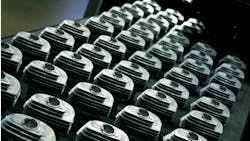Power Tool Maker Cuts Risks, Works Longer, and Safer
In Huskvarna, Sweden, the diecasting and machining operations at Husqvarna Group’s extensive manufacturing facility produces multiple different aluminum and magnesium castings for the group’s line of power tools, including crankcases, flywheels, cylinders, oil pumps and clutch covers. It uses a multiple processes (melting, casting, machining, honing, and painting) before assembling the parts into finished products.
All the operations are highly automated, and the diecasting and machining processes involve multiple diecasting machines and CNC machine tools. Computer control and high precision robotics keep everything organized and in progress, with operators handling the specific tasks of grinding and finishing cast parts.
Because CNC machines can conduct multiple processes in sequence, without having to stop/start the machine, it’s necessary to have different tooling options stored in a magazine to adjust set-ups without stopping the machine. Of course, this also indicates that the machines are working at very high speeds and temperatures, so it’s necessary to use cutting fluids to cool the tools and the parts and provide lubrication during machining.
However, cutting fluids bring a major risk, because cutting fluid emulsions will “go bad” over time. Especially during inactive periods, bacteria will grow, multiply, and die in the fluid – emitting a foul odor. Apart from the smells, bacterial contamination is a risk to workers’ health, and the cutting fluid baths need to be fully replaced, sometimes as frequently as twice per year. Aside from the waste of the solution, it’s the cause of downtime that undercuts productivity.
“Cutting fluid is an essential part of the machining process, as it ensures that tools and work pieces are sufficiently cooled and lubricated,” explained Jens Gustafsson, process engineer. “This enables us to meet the necessary close tolerances while at the same time giving us the benefits of effective operation and long tool life.”
Husqvarna decided to stop tolerating the issues arising from bacterial contamination, and to address the problem “with a more sustainable solution,” Gustafsson said.
The team at Husqvarna presented its problem to MetallChemie AB, a Swedish a distributor for Henkel metalworking products. Tomas Holmér, owner of MetallChemie, proposed the bactericide-free Bonderite L-MR range of cutting fluids. A new product at that time, the fluids have a long bath-life proven in many industrial applications worldwide, partly because of its high hardwater stability.
Husqvarna ran a six-month comparative test, evaluating various products and options including the Bonderite L-MR cutting fluid. The Henkel technology performed well and now has been in continuous use for over three years.
“Firstly, there is a noticeable absence of smell, a major step forward,” Gustafsson said. “A key health benefit is that we do not have bactericides in our production process now.”
However, he also emphasized that the operation saves time and costs thanks to the new formulation. “Although we do check the cutting fluid during every shift change, we certainly do not have to change or refill the bath as frequently as before.”
The longer performance life between replacements has saved the plant two full days of production every year, and there is less waste fluid to be disposed of as a result, which is an environmental benefit, too.
“Moreover, tools last longer because the concentration and emulsion quality of the Bonderite L-MR cutting fluid is more stable over time,” he said.
The partnership between Husqvarna and MetallChemie goes beyond the traditional customer/supplier relationship: Holmér tours the operation every five weeks to offer on-the-spot support as needed, and to carry out a range of tests to monitor a number of critical parameters, such as a concentration and pH-balance check.
Of the Henkel cutting fluid products, Holmér said his customers “all appreciate the quality of the product range both for aluminum and magnesium parts. Because we make regular site-calls and tests, we are able to take timely measures if anything were to go wrong. But in truth, the (Henkel bactericide-free cutting fluids) product is so good that it requires little or no trouble-shooting.”
The Husqvarna team is pleased with its improved performance and endorses Bonderite L-MR cutting fluids as a factor in promoting sustainability for metal parts manufacturing, saving time and costs, and with significant health benefits.
